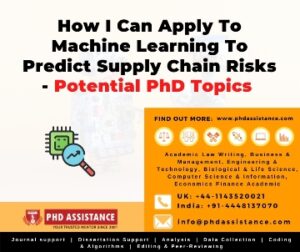How I Can Apply To Machine Learning To Predict Supply Chain Risks- Potential PhD Topics
In a world full of competition where every business is struggling to put itself ahead, Machine Learning (ML) can grant some exclusive opportunities. From increasing profit margins to reducing costs and engaging customers, machine learning can help you in many ways.

As the world is triggered by the COVID-19 situation, managing and handling the supply chain risk is what everyone is thinking about. From lowering the risk and improving the forecast accuracy machine learning is the USB in the supply chains.

The role of ML in predicting supply chain risks
This application is based on artificial intelligence that searches for trends, accuracy, patterns and quality which makes your experience better in the system. Especially the ML algorithms which lead to the platform of supply chain management helps to predict various risks involved from unknown factors this will help in keeping up the constant flow of all goods in the supply chain.
Importance of ML in supply chain risks
Many renowned firms are now paying keen attention to ML to improve their business efficiency and predict risk in supply chains. So, let’s take some time to understand how AI addresses the various problems involved in supply chains. Moreover, we will also learn about the advanced Technologies role in the Management of the supply chain.
- Cost efficiency:
ML can be great in waste reduction and improving the quality. It can have an enormous impact on the supply chains. The power lies in its algorithms that detect the pattern from the data and help in predicting the involved risks in supply chains. ML can continuously integrate information and emerging trends to meet the new demands. Thus, it’s very useful for retailers and business to deal with aggressive markdowns and helping them in cost efficiency.
- Enables product flow:
With its set sequential operations it enables smooth product flow. It monitors the product line and ensures the targeted process of production is achieved. It offers an overview of the system thus it minimizes risks involved in the supply chain.
- Transparent management:
MI can communicate and explain the risk involved in supply chains with transparency. It helps humans to understand the procedure and take the right decision. From e-commerce giants too small to medium-sized business MI helps to manage their sales and predict future risks with transparency. Moreover, it helps in relationship management because of its faster, simpler and proven practices in administrative work.
- Quick solution for problems:
MI helps to resolve problems quickly with the help of previous data. The MI prediction is based on outcomes of the past results from data. It is best to deal with unbiased analysis of quantified factors to generate the best outcome.
Interpretation based on Machine Learning
ML is a way of Programming with Artificial Intelligence. It replaces set rules of calculations with the program. With the given set of data, algorithms statistics, it combines and represents in a model form. These models will make predictions based on the input data.
It involves computer-aided modelling for supply chains. It is a process to enhance performance and limit risks with concrete predictions. With the Help of Data Collection, MI concludes with precise algorithms. MI is perfect to manage the supply chain and deal with all the risk involved in it.
Working up with AI
Companies that are new to AI can begin with a system to obtain an actionable solution to problems in the supply chain. Once businesses gain confidence with the system they can be assured that it can make changes accordingly to improve operational requirement. With the system improving it can determine the various impact on the company’s KPIs (key performance indicators). Later it can make an instant decision related to the supply chain to get the best business outcomes.
Some new supply chains have achieved good improvements in the error rates by using ML methods. These improvements lowered the risks involved in supply chains. With AI, you can have a better delivery time, forecast demand, production and able to meet the deadline of customers order and also in other aspects of the business. AI ensures smooth flow of the supply chain with risk protection.
FUTURE RESEARCH TOPICS
|
S.No |
Type of Data | Algorithm | Purpose |
References |
|
1 |
Patients data | Machine Learning | To identify key biomarkers to 23predict the mortality of individual patient |
[1] |
|
2 |
Ontology database(risk hidden danger database) | OntoLFR(Logistics Financial Risk Ontology + Apriori algorithm | To adapt to the variability, complexity and relevance of risk in early warning and pre-control. | [2] |
| 3 | Cloud Database | Block chain machine learning-based food traceability system | The blockchain data flow is designed to show the extension of ML at the level of food traceability.
Moreover, the reliable and accurate data are used in a supply chain to improve shelf life. |
[3] |
|
4 |
Business Data | Statistical approach for power control based upon multiple costing frameworks using a machine learning model (SCM–MLM) | To evaluate idleness and create techniques to optimize the profitability of the enterprise. The maximization of trade-off capacity against organizational performance is demonstrated and it is seen to be organizational inefficiency by power optimization has been validated |
[4] |
|
5 |
Data
from physical sources (e.g. ERP, RFID, sensors) and cyber sources (e.g. blockchain, supplier collaboration portals, and risk data) |
Digital supply chain twin – Industry 4.0 | Research and practice of SC risk management by enhancing predictive and reactive decisions to utilize
the advantages of SC visualization, historical disruption data analysis, and real-time disruption data and ensure end-to-end visibility and business continuity in global companies. |
[5] |
Conclusion
The efficiency level of the supply chain is crucial for businesses. Operating businesses with tight profit margins and with certain improvements can impact the overall profit line of the business. MI Technologies make the job simple to deal with various challenges of forecasting and volatility demand involved in supply chains. Moreover, it ensures efficiency, profitability and better management of the supply chain.
References
- Chowdhury, M. E., Rahman, T., Khandakar, A., Al-Madeed, S., Zughaier, S. M., Doi, S. A., … & Islam, M. T. (2021). An early warning tool for predicting mortality risk of COVID-19 patients using machine learning. Cognitive Computation, 1-16.
- Yang, B. (2020). Construction of logistics financial security risk ontology model based on risk association and machine learning. Safety Science, 123, 104437.
- Shahbazi, Z., & Byun, Y. C. (2021). A Procedure for Tracing Supply Chains for Perishable Food Based on Blockchain, Machine Learning and Fuzzy Logic. Electronics, 10(1), 41.
- Wang, D., & Zhang, Y. (2020). Implications for sustainability in supply chain management and the circular economy using machine learning model. Information Systems and e-Business Management, 1-13.
- Ivanov, D., & Dolgui, A. (2020). A digital supply chain twin for managing the disruption risks and resilience in the era of Industry 4.0. Production Planning & Control, 1-14.
- Baryannis, G., Dani, S., & Antoniou, G. (2019). Predicting supply chain risks using machine learning: The trade-off between performance and interpretability. Future Generation Computer Systems, 101, 993-1004.
- Asrol, M., & Taira, E. (2021). Risk Management for Improving Supply Chain Performance of Sugarcane Agroindustry. Industrial Engineering & Management Systems, 20(1), 9-26.
 Previous Post
Previous Post Next Post
Next Post
